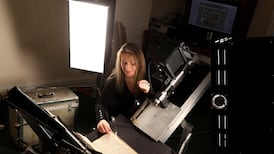You work in the field of crystal engineering, what is that?
Crystals are solids that have repeating patterns of atoms, molecules or ions in their structure. Crystal engineering is the field of chemistry that looks to better understand existing crystals in order to make new crystalline materials, so we can harness their properties.
We and others are most interested in using these new crystals in lots of applications where crystalline materials are important, from purifying natural gas to water harvesting to making better and cheaper pharmaceuticals.
Being able to understand and design the material from the ground up means you can really focus on solving a problem, in the same way that an architect can design a building with a specific purpose in mind.
What kinds of problems are you looking to solve?
I am interested in solving really big problems, and one of the biggest challenges facing humanity today is the scarcity of clean water that can sustain life. Fresh water is a limited resource, and many areas of the world are coming under increasing pressure.
How could crystalline materials help there?
My lab has been looking at crystalline materials that are desiccants, meaning they can take water from the atmosphere. We now have a material that can capture water from the air and release it with a low need for energy input.
Based on this, we are working with an industrial partner – Molecule.ie – on developing an atmospheric water generator system that can pull clean, drinkable water from the atmosphere. That means where there is a lack of water or contamination of available water, you could pull clean water from the air, even in the middle of the Sahara desert.
How did you find this material?
It was one my lab had already made, but we hadn’t looked at it for this purpose. Then I spoke at a conference in London, and by chance I met people from a think tank and research fund called Molecule. They were interested in developing new materials to address climate and sustainability issues, so we started working with them on water capture.
We came up with new ways of testing materials in our lab, and we found that we had some materials that could fit the bill.
You are about to start a European Research Council advanced grant project on capturing gases, and you recently became a member of the Royal Irish Academy. What is your advice to people about being innovative in research?
That often we already have the solutions, but they have to be matched with the right problems. When you have a motivation to go looking, then you may find that new technology is relatively easily within reach and sometimes the solutions are surprisingly simple. This, however, still requires partnerships, typically between government, industry and universities. Ireland has become very good at this.
How has Covid-19 affected your research?
We used the three months of lockdown for paper writing and planning. It was an opportunity to take a high-level view of where we stand, and was fully enabled by remote meetings. If the lockdown had lasted longer it would have been hugely detrimental, but fortunately we are now back in the lab on a shift basis with social distancing.
How do you take a break from it all?
I have no need for breaks in the usual sense, as I have been fortunate enough to travel around the world many times to present seminars at conferences or universities. I have therefore had the opportunity to visit many interesting, beautiful places and enjoyed being the guest of gracious hosts.










